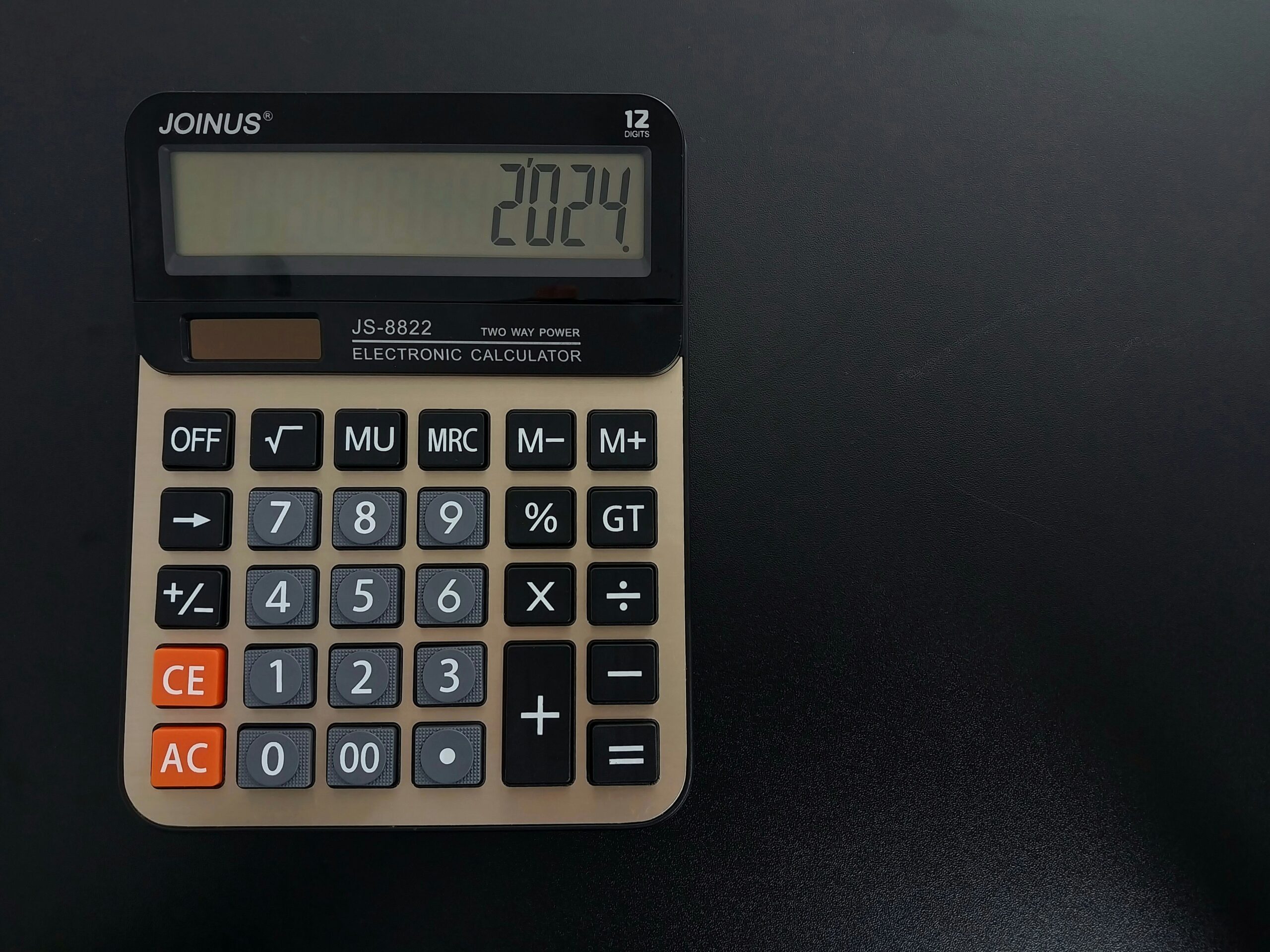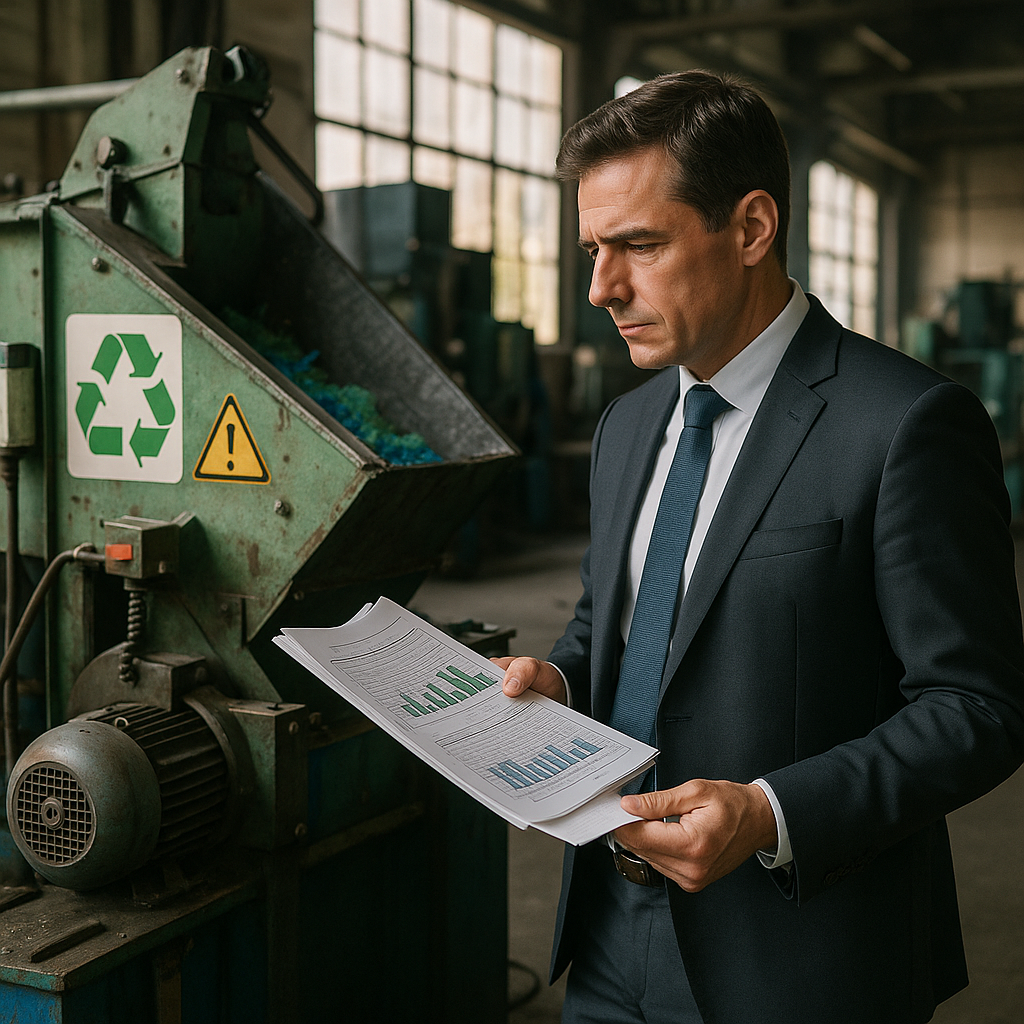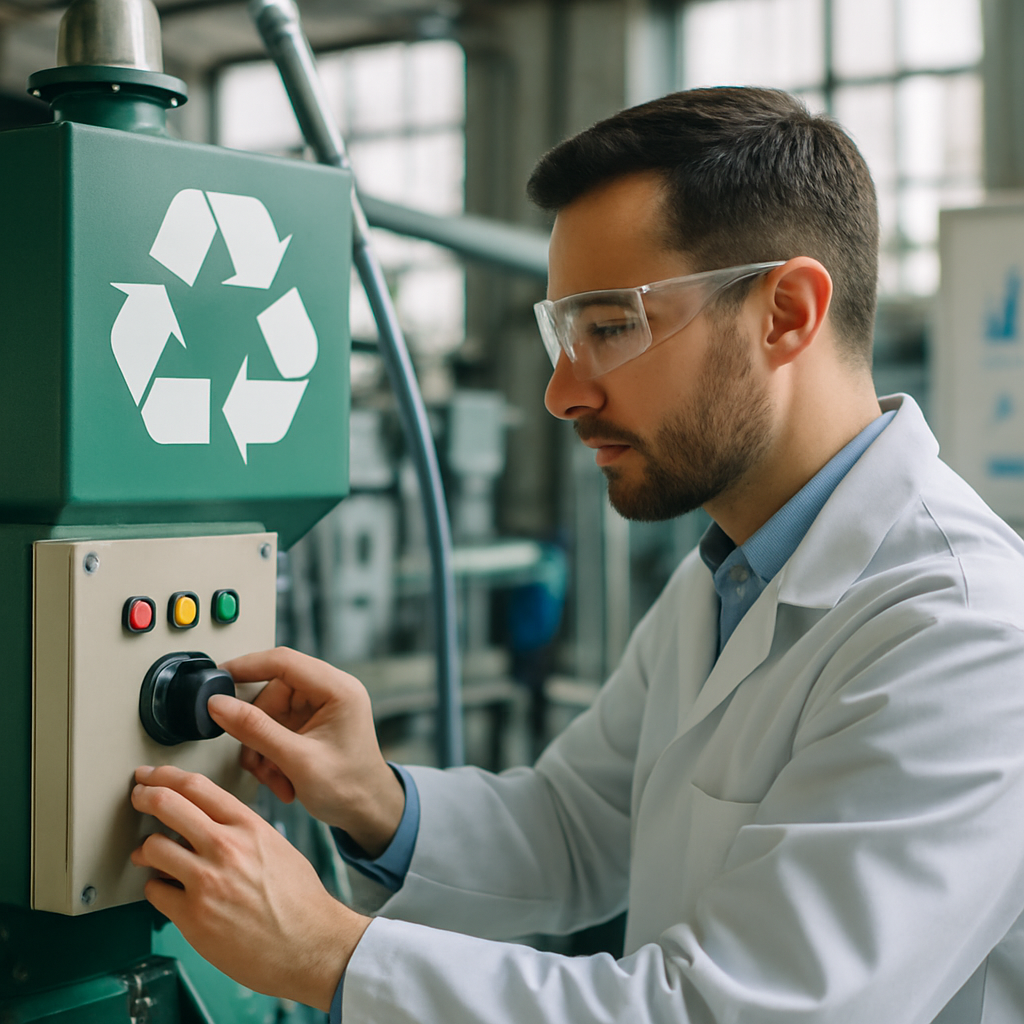5901 Botham Jean Blvd, Dallas, TX 75215
What is ROI and Why is it Important for Recycling Equipment?
July 17, 2025The recycling industry faces distinct challenges when evaluating equipment investments. The volatile nature of commodity markets, regulatory changes, and evolving waste streams all affect the potential returns from machinery purchases. Whether you are considering a baler that reduces transportation costs by 80%, a material recovery system that increases throughput, or specialized processing equipment that opens new revenue streams, ROI calculations provide the financial clarity needed to make informed decisions.
Beyond justifying purchase costs to stakeholders, ROI analysis serves several important functions. It helps align equipment investments with broader financial goals, establishes realistic timeframes for equipment to become profitable, and provides a standardized method to compare different investment options.
For sustainability-focused operations, ROI also demonstrates how environmental benefits can translate into tangible financial returns, creating a compelling case for investment in advanced recycling technology.
How Do You Calculate ROI for Recycling Equipment?

Calculating the return on investment (ROI) for recycling equipment helps waste management facilities determine if their investment will be profitable. The basic formula is straightforward, but requires careful consideration of all costs and revenue sources.
The ROI Formula for Recycling Equipment
The standard formula for calculating ROI is:
ROI = (Net Profit – Costs) / Costs × 100
This formula yields a percentage representing the return relative to your investment. A positive percentage indicates profitability, whereas a negative percentage indicates a loss.
Step 1: Determine Total Cost of Ownership
The first step is calculating all costs associated with the recycling equipment. This includes:
- Purchase price of the machinery
- Installation and setup costs
- Training expenses for staff
- Operational costs (energy consumption, labor)
- Maintenance and repair expenses
- Any facility modifications needed to accommodate the equipment
For example, if a baler costs $50,000 to purchase, requires $5,000 for installation, and $10,000 annually for maintenance and operation, your total cost over five years would be $105,000.
Step 2: Calculate Net Profit
Next, determine the net profit generated by the equipment. This includes:
- Revenue from selling recycled materials
- Savings from reduced waste disposal costs
- Labor savings from automation
- Any tax incentives or rebates for recycling operations
Subtract operational costs from these revenue sources to determine your net profit.
Step 3: Apply the ROI Formula
With your total costs and net profit figures, apply the formula to calculate ROI.
Consider this example: A material recovery facility invests in a new sorting system with these financials:
- Equipment purchase: $250,000
- Installation: $30,000
- Annual operational costs: $45,000
- Expected lifespan: 5 years
Total 5-year cost = $250,000 + $30,000 + ($45,000 × 5) = $505,000
If the system generates $150,000 annually in additional revenue and savings:
Total 5-year revenue = $150,000 × 5 = $750,000
Net profit = $750,000 – $505,000 = $245,000
ROI = ($245,000 / $505,000) × 100 = 48.5%
This 48.5% ROI over five years indicates a profitable investment, equating to approximately 9.7% annually.
Important Considerations
When calculating ROI for recycling equipment, consider these factors:
- Market fluctuations can affect the value of recycled materials
- Equipment performance may decline over time, increasing maintenance costs
- New regulations might require additional investments or create new opportunities
- Improved efficiency often leads to intangible benefits, such as better working conditions
For more accurate projections, perform ROI calculations using different scenarios—conservative, moderate, and optimistic.
What Factors Affect ROI for Recycling Equipment?

Return on investment (ROI) for recycling equipment represents a critical metric when evaluating machinery purchases in waste management operations. Various factors influence this calculation, leading to variations in payback periods and long-term profitability across different operational contexts. Understanding these variables helps organizations make informed decisions when investing in recycling technology.
Processing Capacity and Throughput
Processing capacity directly impacts how quickly recycling equipment can deliver returns. Higher capacity systems require greater initial investment but can process more material in less time. The relationship between capacity and ROI functions in several ways:
- Volume scaling – Equipment that can handle larger volumes spreads fixed costs across more processed material, reducing per-unit processing costs.
- Material flow optimization – Systems with the appropriate capacity for your waste stream prevent bottlenecks that reduce efficiency and slow returns.
- Throughput consistency – Machines with steady, reliable throughput rates help create predictable revenue streams, making ROI projections more accurate.
Automation Level and Technology Integration
The degree of automation in recycling equipment significantly affects both initial costs and operational expenses. Advanced systems command higher purchase prices but offer operational benefits that can accelerate ROI:
- Labor reduction – Automated systems typically require fewer operators, reducing wage expenses and improving profit margins over time.
- Sorting accuracy – Advanced optical sorters and robotic systems achieve higher material purity rates, producing more valuable output that commands premium market prices.
- Data collection – Modern equipment with integrated monitoring systems allows for continuous performance optimization, helping operators identify and resolve inefficiencies that impact returns.
Energy Efficiency and Utility Costs
Energy consumption represents a significant operational expense for recycling equipment. The relationship between energy efficiency and ROI includes:
- Power requirements – Equipment with lower energy demands reduces monthly utility bills, improving operational margins throughout the equipment lifecycle.
- Standby efficiency – Systems with intelligent power management during idle periods or partial loads conserve energy during operational fluctuations.
- Heat recovery options – Advanced recycling systems that capture and reuse process heat for facility heating or other applications create additional cost savings that improve ROI.
Maintenance Requirements and Reliability
Maintenance costs can significantly impact the total cost of ownership and affect ROI calculations in several ways:
- Preventive maintenance schedules – Equipment requiring less frequent servicing reduces both direct maintenance costs and operational downtime.
- Parts availability – Machinery with readily available replacement components minimizes repair delays and associated production losses.
- Durability in harsh conditions – Recycling equipment faces abrasive materials and contamination. Systems built with wear-resistant components extend service life and maintain performance levels longer.
Market Conditions for Recycled Materials
External market factors create some of the most significant variables in recycling equipment ROI calculations:
- Commodity price fluctuations – Recycled material values change with market demand, directly affecting revenue streams and ROI timelines.
- Quality premiums – Equipment that produces higher purity output streams can access premium markets with better pricing, enhancing returns.
- Local market access – Transportation costs to material buyers impact net revenues. Equipment that processes materials for nearby markets may achieve faster returns.
Equipment Utilization Rates
How efficiently recycling equipment is used dramatically affects ROI performance:
- Operational hours – Machinery running at higher utilization rates spreads fixed costs over greater output volume, accelerating returns.
- Downtime management – Equipment with quick changeover capabilities between material types minimizes non-productive periods.
- Seasonal fluctuations – Systems designed to handle variable input volumes maintain efficiency during periods of lower material availability.
Regulatory Compliance and Incentives
The regulatory environment creates both requirements and opportunities that affect recycling equipment ROI:
- Compliance costs – Equipment meeting current environmental and safety regulations avoids expensive retrofits or penalties that would decrease returns.
- Government incentives – Tax benefits, grants, and subsidies for sustainable technologies can significantly improve initial investment equations.
- Carbon credits – In some regions, recycling operations can generate additional revenue through carbon offset programs, enhancing equipment ROI.
Understanding these interrelated factors helps recycling operators develop more accurate ROI projections when evaluating equipment investments. The most successful operations conduct thorough analyses of these variables within their specific operational context rather than relying solely on industry averages or vendor projections.
How Can You Maximize ROI on Recycling Equipment?

Investing in recycling equipment is a significant expense for any waste management operation. To maximize your return on investment, it requires strategic planning and attention to several key factors. By employing proven optimization strategies, you can ensure that your equipment provides lasting value.
Select Equipment That Fits Your Operational Needs
The foundation of a strong ROI starts with choosing the right equipment for your specific needs. Many operations waste money on oversized or overly complex machinery. Conduct a thorough assessment of your waste volume, material types, and processing goals before making any decisions.
Choose equipment that meets your current needs while allowing for reasonable growth. For example, if you primarily process cardboard and paper, a vertical baler with appropriate capacity ratings will offer better returns than a more costly horizontal system designed for various materials.
Prioritize Energy Efficiency
Energy consumption is one of the largest ongoing operational costs for recycling equipment. Modern energy-efficient models may have higher upfront costs but provide substantial savings over their lifespan. When evaluating equipment options, closely compare energy usage specifications.
Look for features like automatic shutdown systems that power down equipment during idle periods. Advanced compactors and balers with real-time monitoring can optimize power usage based on the materials processed, reducing energy consumption by up to 30% compared to older models.
Implement Comprehensive Maintenance Programs
Regular maintenance is crucial for maximizing equipment lifespan and efficiency. Develop and follow a preventive maintenance schedule based on manufacturer recommendations and your specific usage patterns. This proactive approach helps avoid costly breakdowns and extends the useful life of your investment.
Key maintenance practices include inspecting hydraulic systems, lubricating moving parts, and timely replacement of wear components. Training operators to perform basic daily maintenance checks can help identify potential issues before they cause significant damage or downtime.
Optimize Processing Efficiency
The efficiency of your recycling operation directly impacts ROI. Streamline material handling processes to minimize labor costs and maximize throughput. This includes optimizing facility layouts to reduce unnecessary movement of materials and training staff on proper equipment operation techniques.
Consider workflow improvements such as pre-sorting stations that remove contaminants before materials enter processing equipment. This reduces wear and tear while enhancing the quality and value of your recycled outputs.
Consider Total Lifecycle Costs
When determining ROI, look beyond the initial purchase price to evaluate total lifecycle costs. This includes expected equipment lifespan, maintenance requirements, energy consumption, and potential resale value. Equipment with longer operational life often delivers better returns despite higher upfront costs.
Additionally, assess the availability and cost of replacement parts and service support. Equipment from manufacturers with robust service networks and readily available parts typically offers better long-term value than cheaper alternatives with limited support.
Explore Upgrade Potential
The recycling industry technology continues to evolve rapidly. Choose equipment with upgrade paths that allow for incorporating new technologies without complete replacement. Modular systems that permit component upgrades can extend the useful life of your investment while keeping pace with industry advancements.
For example, some balers can be retrofitted with advanced control systems or hydraulic components that improve performance and efficiency. This flexibility can significantly enhance your long-term ROI by delaying the need for complete equipment replacement.
Monitor Performance Metrics
Implement systems to track key performance indicators related to your recycling equipment. Monitoring metrics such as throughput rates, energy consumption, maintenance costs, and downtime helps identify optimization opportunities and make data-driven decisions about equipment upgrades or replacements.
Regular analysis of these metrics ensures your equipment continues to deliver maximum value. If performance begins to decline or maintenance costs increase significantly, it may indicate that replacement would provide better returns than continued operation of aging equipment.
Conclusion: Making Informed Recycling Equipment Investments

Calculating and maximizing ROI is essential for making sound recycling equipment investments in today’s competitive market. The financial success of recycling operations hinges on understanding key factors such as initial acquisition costs, operational efficiency, and potential revenue streams from recyclable materials. By implementing strategies to improve ROI—like investing in advanced technology, establishing preventive maintenance programs, and optimizing operational processes—recycling facilities can transform a significant expense into a profitable long-term venture.
The recycling industry continues to evolve with technological advancements that enhance processing efficiency and reduce costs. Companies that strategically assess their equipment needs, market conditions, and regulatory requirements position themselves for sustained profitability. Regularly reassess your ROI calculations as market conditions change to ensure your investments continue to deliver maximum value. This proactive approach helps identify areas for improvement and adaptation before they impact your bottom line.
For guidance on recycling industrial equipments, contact Okon Recycling at 214-717-4083.
